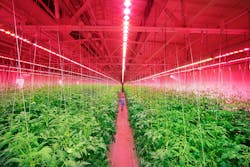Signify has announced some details of a horticultural lighting project in Russia in which supermarket owner RIAT is growing tomatoes and vegetables for its stores indoors with nothing but artificial light supplied by Philips GreenPower LED luminaires. The fully indoor facility that is reliant totally on solid-state lighting (SSL) is said to be matching the yield of greenhouses with supplemental LED lighting.
Signify and RIAT launched a trial of indoor vegetable farming back in 2019 and the RIAT operation has now moved to commercial production after success in the trial. While a greenhouse with supplemental SSL may have seemed like the logical direction for RIAT to take for the trial, the company decided to test the indoor operation because the company had such a facility readily available that could handle the plants that grow as tall as 3.5m.
“We already had facilities of sufficient height at our disposal, therefore there was no need to invest in building a glass construction,” said Vladimir Bukharev, director at RIAT. “But as the building had no windows, we needed a high-quality lighting system to fulfill the intensive lighting requirements of tomatoes and cucumbers. In 2019, Signify provided its Philips GreenPower LED grow lighting, helping us to achieve a yield performance comparable to traditional greenhouse operations.”
The indoor farm is located centrally in Ivanovo, enabling the company to distribute produce easily to its dozen stores in the regions. The primary production at the farm is tomatoes and cucumbers and the company is exploring the growth of some other crops.
Signify described the project as a vertical farm, although it does not presently have any layering of crops that is typical of vertical farms. We first covered the vertical farm concept back in 2014 in an article on Green Sense Farms near Chicago. And we have seen some variation in vertical concepts since.
In the RIAT project, the tomato and cucumber plants do grow very tall and that may have prompted the use of vertical as a descriptor. The RIAT operation does share the attribute of having only artificial light with the typical vertical farm.
Signify supplied both toplighting fixtures and interlighting products that are located between rows of plants for the RIAT project. Both types of fixtures are part of the Philips GreenPower portfolio. The interlighting supplies energy to lower portions of the plant which are blocked from the top lights by the canopy of the plant.
RIAT realized success almost immediately in trialing the indoor growing technology. “With a harvest of 2.7 to 3.2 kg of cucumbers per square meter every week, and 1.7 kg per square meter of tomatoes, we started making a profit as of the second year of operation,” Bukharev said. “In addition to that, the quality of the product is very high, there’s hardly any waste, and we sell 99% of what is being grown.”
There are several other elements of the lighting and the farm design that RIAT and Signify have identified as factoring into the success of the operation. Signify would not identify the spectra being used, but did indicate that it includes monochromatic red and blue along with phosphor-converted white and perhaps more. And a quote from another Signify representative implies that the spectra is tunable. “While using different kinds of lights, the light recipe can be adjusted based on the crop that is grown,” said Sergey Khokhrin, business development manager, CEE/Russia & CIS at Signify.
The farm is also using bees for pollination. And bees don’t always function well under LED light without a broad spectral power distribution (SPD) that at least resembles natural light. But the farm said that the SSL being used is bee friendly.
The RIAT farm has also utilized a technique we’ve seen in Signify-supplied projects previously whereby the stems of the tall plants are essentially folded and the plants are lowered from the top on a recurring basis as the lower part of the stem goes fallow during a bottom-to-top harvest operation. In one of our feature articles a few years back, we covered this technique when implemented at a Stockbridge Technology Centre research farm in the UK.
The photos that Signify distributed with the documentation of the RIAT project do not show the folding in action. Rather, workers are on a raised platform tending the plants. But the photo does show the bare stalk at the bottom. Laying or folding that stalk parallel to the ground enables workers standing on the floor to tend the area of the plant under harvest at any given time. And Signify did provide a link to a video of a different project that better illustrates the concept.
RIAT is apparently sold on the SSL technology and indoor approach. “By using Philips LED lighting modules, we managed to achieve maximum stability and a light output of 18 g/mol,” said Bukharev. “This is why we chose Signify. The area equipped with LED lamps is currently 3800 square meters. Soon, we are going to launch a new area of 700 square meters to grow lettuce, which will also be equipped with Philips LED lighting.”
Indoor vegetable farming is just one of many topics that will be on our agenda at the HortiCann Light + Tech Conference scheduled for October.
For up-to-the-minute LED and SSL updates, why not follow us on Twitter? You’ll find curated content and commentary, as well as information on industry events, webcasts, and surveys on our LinkedIn Company Page and our Facebook page.






